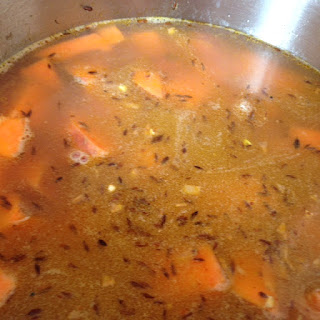Pickling is one of the oldest methods of food preparation
Pickling is one of the
oldest methods of food preparation and was developed to preserve foods that were
either exotic, seasonal or limited by
nature and cultivation. Early pickling can be traced
back to India around 4,000 to 5,000 years ago. The process was created to
overcome the problem of low food production during the hot, dry summer months
and the need to preserve excess food produced during the Winter.
Pickling has been used
throughout the world and the ingredients vary slightly from one country - often
from one región or village - to another. Many fruits and vegetables are used
such as, unripe fruit, lemon, tamarin, cauliflower, carrots, cucumbers,
cabbage, lettuce, soybeans, ginko nuts, plums, apricots, apples and tomatoes.
Condiments such as miso, ginger, garlic, chilli, or peppercorns are often added
for a hot and characteristic flavour. Animal food was also pickled in many
countries including, eggs, oysters, prawns, chicken, fish and lamb.
Interestingly, Pickles in
the West generally have sweet, sour, and salty flavors, while Indian pickles
are more pungent in taste to help disperse heat.
Health Benefits of Pickles
Full of essential vitamins and minerals – these vital
micronutrients protect from disease, help build immunity, strengthen the bones,
nourish vision, and improve anemia and blood conditions.
Full of antioxidants - As the
vegetables or unripe fruits are stored fresh without cooking, the antioxidants
present are preserved.
Great source of probiotics and gut friendly bacteria - Naturally
fermented salt pickles encourage the growth of friendly bacteria, which replenishes
the numbers in the digestive system and restores health.
Diabetes Control: vinegar based
pickles can improve the hemoglobin levels in diabetic patients
Improve mental health
Cancer risk reduction
Inflammation relief
Improves digestion, protects the liver and helps heal
ulcers
Some Quick and Easy Pickle Récipes
Quick Homemade Cucumber Pickles with Fresh Dill
Ingredients:
4-6 small pickling cucumbers
2 cloves garlic sliced
1 sprig fresh dill
1/2 cup Apple cider vinegar
1 ½ cups water
2 tablespoons sea salt
1/4 onion sliced in half moons
1 teaspoon peppercorns (optional)
1 teaspoon mustard seeds
(optional)
Preparation
Slice the cucumbers into
quarters lengthwise
Place the cucumbers and fresh dill into a bowl or a jar.
Place the salt, vinegar,
wáter, garlic, peppercorn and mustard sedes into a pan.
Bring to a boíl on a médium
flame.
Pour boiling liquid over the cucumbers, making sure they're entirely submerged.
Place a slice of onion on top of the cucumbers to help them all stay beneath
the liquid.
Leave on the counter overnight to marinate
Store covered in the fridge.
Cauliflower Pickles
Ingredients
3 cups cauliflower, cut into
chunks
1 large garlic clove, crushed
1 tablespoon dry dill
3-4 peppercorns
1 bay leaf
1.5 tablespoons sea salt
1-2 teaspoons ume vinegar
2-3 cups filtered water
Preparation
Wash a jar with very hot,
soapy water.
Cut the cauliflower into
florets
Finely slice the garlic
clove, and add to jar with herbs and peppercorn.
Add cauliflower, pressing
down firmly into jar so the florets are tightly packed, leaving 1" space
at the top of the jar.
Dissolve the salt and ume
vinegar in 2 cups of water, and add to the jar.
Add additional water as
necessary to cover vegetables. Leave a 1" space at the top of the
jar.
Leave to sit for 3-5 days at
room temperature, in a cool place away from the sun. In warmer
temperature, 3 days is usually enough.
Test them and to see if they
have a good pickly flavor. If you want a stronger flavor, leave them out
longer, up to 7 days depending on the temperature.
Open the jar over the sink
as it can fizz and bubble over.
Store the ready to eat
pickles in the fridge.
Pickled Cabbage and Apple Delight
This is more of a side dish but has a wonderful
pickled flavor
Ingredients
2 tablespoons olive oil
2 cloves garlic sliced
1/2 onion diced
1 green apple, cored and cut into small chunks
½ medium-sized head red cabbage,
shredded
pinch ground cloves (optional)
2 tablespoons apple cider vinegar
Spring water
salt and pepper to taste
Chopped roasted walnuts
Preparation
Place the oil into a pan and
warm on medium heat, then add the garlic. Sauté quickly and then add the onions.
Sauté for a few minutes and then add the Apple. Saute for another minute.
Add the shredded cabbage,
cloves, apple cider vinegar, and enough wáter to cover the bottom of the pan.
Add a lid and bring to a
boíl., Simmer on a low flame until the cabbage is soft, about 20-30 minutes.
Gentle toss the cabbage from
time to time to evenly distribute the ingredients.
Season with salt and pepper mix
gently and serve garnished with walnuts. The flavor of this dish improves if
served the following day.

















